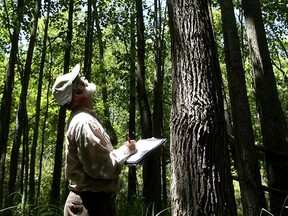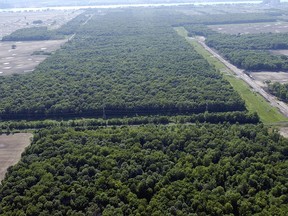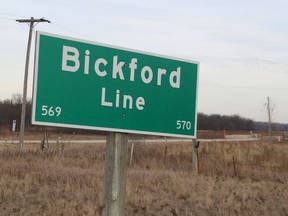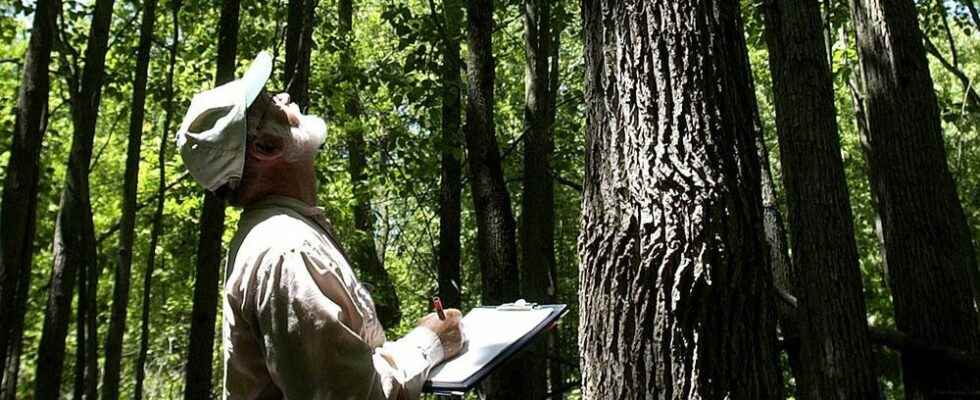
The Bickford Oak Woods, a forest along Highway 40 in St. Clair Township, has been named one of Canada’s first Key Biodiversity Areas as part of an effort to identify the country’s most critical places for nature.
Canada’s Key Biodiversity Areas (KBA) program was officially launched in October by the Wildlife Conservation Society Canada, Birds Canada and NatureServe Canada using a process developed internationally, according to the groups.
The Bickford Oak Woods includes a 314-hectare conservation reserve, said to be largest protected Carolinian clay plain forest in Canada, that is home to several rare plant and wildlife species.
“We’ve been working in Ontario for over a year now and we’ve kind of slowly rolling out the nominations,” said Robyn Rumney, regional co-ordinator for Ontario’s Key Biodiversity Areas.
Bickford Woods is one of about 10 locations officially named so far from among the more than 100 locations the program is working on in Ontario, she said.
“One of the reasons is it’s the only site in Canada where a tree called swamp cottonwood has been confirmed,” making it “a clear-cut KBA,” Rumney said.
Bickford Woods is the only spot in Canada where that tree has been found.

It’s also home to the provincially rare pin oak, Shumard oak, buttonbush thicket, cerulean warbler, tufted titmouse and Carolina wren.
“We’re looking for sites where a species or ecosystem is disproportionately concentrated in Canada, making the site really important for conservation at a global scale,” Rumney said.
Other sites currently designated include the Long Point Peninsula and marshes.
The areas range from small pockets of nature in big cities to remote wild areas of the country. While the designation doesn’t provide legal protection, the groups say it identifies places where conservation and stewardship efforts “can have a large impact on halting and reversing the loss of nature,” the groups said in a news release.
“It’s a scientifically rigorous tool that can be used to help identify the most critical places for nature in Canada and elsewhere in the world,” Rumney said.
“By identifying these Key Biodiversity Areas, we can help governments and other organizations to direct their resources to areas where they will have the biggest conservation impact.”
In the heavily populated areas of southern Ontario, wetland and woodland ecosystems have been reduced to small fragments, she noted.
“Bickford Oak Woods is a really great example of an existing Carolinian forest,” much of which has become farmland elsewhere in Ontario, she said.
Larry Cornelis, a local conservationist and naturalist, was involved in efforts a decade ago that saw the formerly privately owned forest purchased with the help of the Nature Conservancy of Canada. The site was then transferred to the province.

The site’s swamp cottonwoods were first identified in 2002 by Gerry Waldron, John Ambrose and Lindsay Rodger while they were carrying out an inventory of species.
“That was pretty exciting news,” Cornelis said.
He visited the land often over the years and carried out surveys of species there with others not far from where the swamp cottonwoods were eventually found.
“If we had walked in the east side of that trail, we might have discovered them,” he said.
Cornelis said swamp cottonwood has been identified in Ohio and Michigan, “so it was always suspected it could be here.”
Cornelis said he always consider Bickford Woods significant because it sits on clay while most provincial parks and nature reserves are on sandy soils that aren’t as easy to farm and less likely to have been cleared.
“This is a really good example of our Carolinian woods on a heavy clay soil” and a “very swampy site,” he said.
“I always thought that made it kind of unique.”
There are a couple of small parking lots on Bickford Line leading to the site, but it doesn’t have any designated trails, Cornelis said.
The site was logged around the late 1980s, which left some “logging lanes that were walkable but they’ve really grown in” over the years since, he said.
That makes exploring the site a challenge.
“You’re definitely bushwhacking. There are no paths to follow,” Cornelis said. “It’s easy to get lost in there.”
